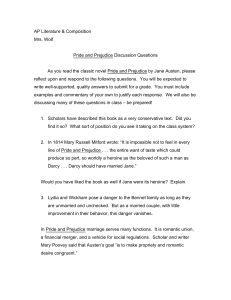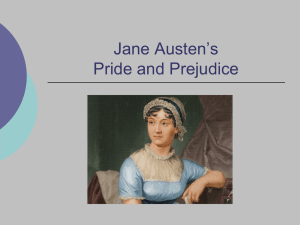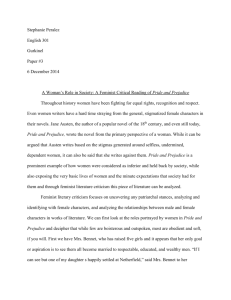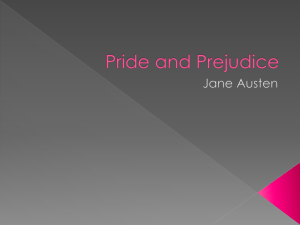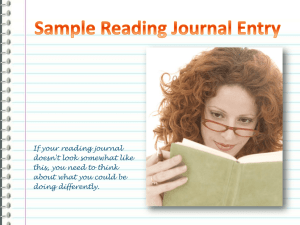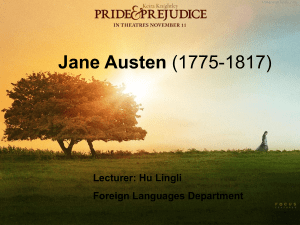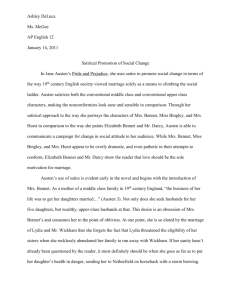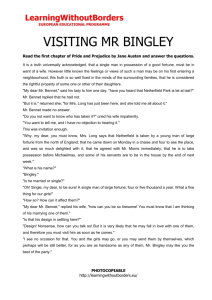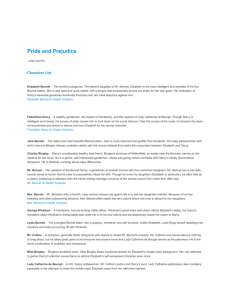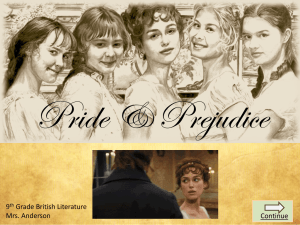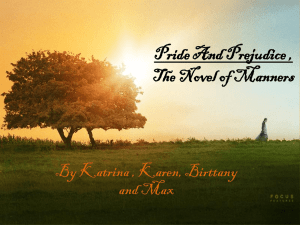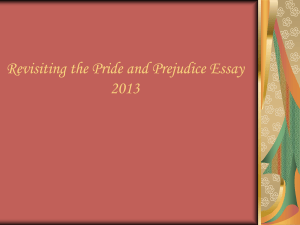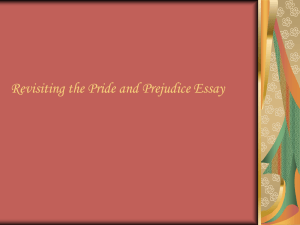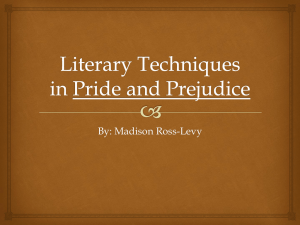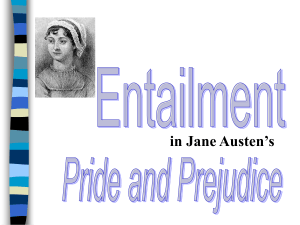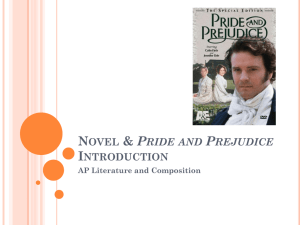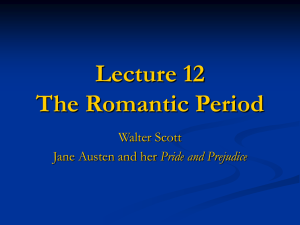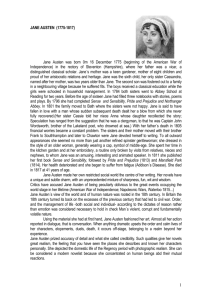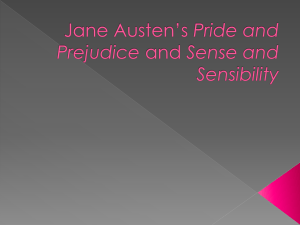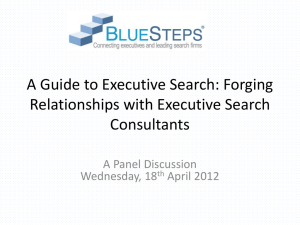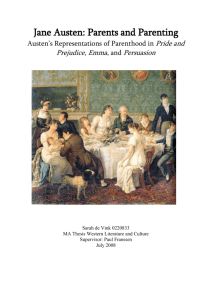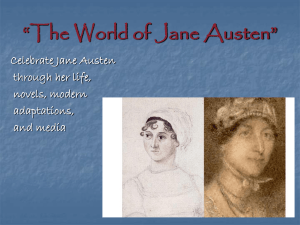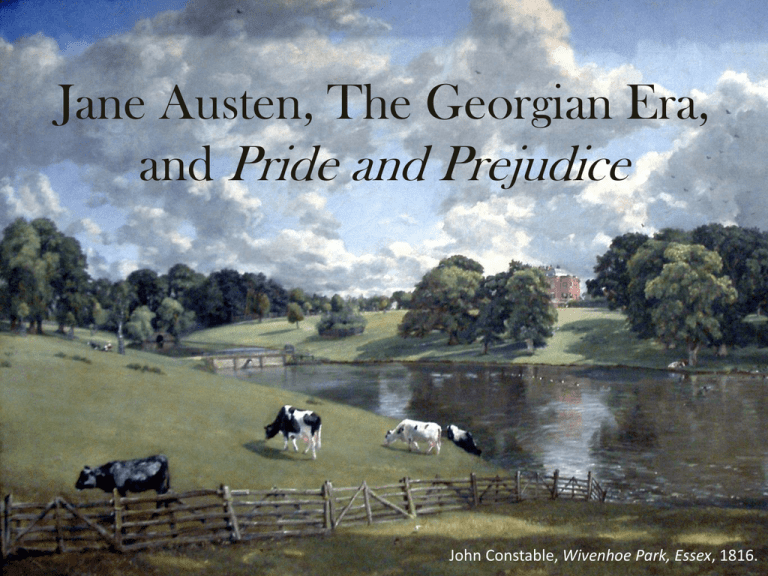
Jane Austen, The Georgian Era,
and Pride and Prejudice
John Constable, Wivenhoe Park, Essex, 1816.
British and World Events 1798-1832
– 1801: Act of Union creates United
Kingdom of Great Britain and Ireland
– 1801: Union Jack becomes official
flag
– 1803: United States: Louisiana
Territory purchased from France
– 1804: Germany: Beethoven
composes Symphony No. 3
– 1804: France: Napoleon crowns
himself emperor
– 1805: Battle of Trafalgar
– 1813: Jane Austen publishes Pride
and Prejudice
– 1831: United States: Edgar Allan Poe
publishes Poems
http://www.youtube.com/watch?v=kwRVR-TmKYw
The Coronation of Napoleon is a painting
completed in 1807 by Jacques-Louis David
Regency Period Research
1. What is the Regency Period? Who was in power in England?
2. How was Austen’s world affected by such international developments as
the Napoleonic War, the American Revolution, and the French
Revolution?
3. What elements of popular culture mark this period? Research styles of
dress, art, music, dance, and games.
4. What was the view of women during this time?
5. Who was Mary Wollstonecraft?
– Suggested Resources:
•
•
•
•
http://www.erasofelegance.com/history/regency.html
http://janeaustensworld.wordpress.com/
http://www.pemberley.com
http://www.lkwdpl.org/lhs/regencyperiod/
Explore the following:
• Classical Music—for example, Beethoven, Rossini, Schubert,
Liszt and Mendelssohn
• Dance—Shift in popularity from country dances to the waltz
which was considered controversial during Austen’s day
• Art—David, Turner, Constable
• History—Napoleonic Wars, French Revolution, American
Revolution (Note that Austen makes no reference to military
actions in this novel, although this was a period of great
change through war.)
• Science—Industrial Revolution, steam locomotion
• Religion—the Evangelical movement, mysticism and other
trends in religion during the late 18th and early 19th century
• Other areas—architecture, fashion, food, sports
The Georgian Era lasted from 1714 to 1830. It is
named after the first four British kings from the
House of Hanover, George I, George II, George III,
and George IV.
Jane Austen (1775-1817) lived entirely in the reign of
George III (r. 1760-1820). Around 1811, George III
went insane, and his son (later George IV) ruled in
his place until the death of his father, a period
known as the Regency.
John Constable, View of Epsom
Dynasty
Monarch
Years
Henry VII
1485-1509
Henry VIII
1509-1547
Edward VI
1547-1553
Mary I
1553-1558
Elizabeth I
1558-1603
Stuart
James I
1567-1625
Charles I
1625-1649
None
Interregnum
1649-1660
Charles II
1660-1685
James II
1685-1688
William III & Mary II
1689-1702
Anne
1702-1714
George I
1714-1727
George II
1727-1760
George III
1760-1820
George IV
1820-1830
William IV
1830-1837
Victoria
1837-1901
Tudor
Stuart
Hanover
George III (r. 1760-1820)
•
•
•
•
American War of Independence (1775-1783)
French Revolution (1789-1799)
Napoleonic Wars (1803-1815)
Industrial Revolution (1750-1850)
– Move from agricultural to urban society
– Growth of factories and technology
John Constable, The Chain Pier, Brighton 1824-1827
Neoclassicism:
(mid-eighteenth century the
middle of the nineteenth
century) classical style; order;
Enlightenment/Age of Reason
Jacques-Louis David, Oath of the Horatii, 1784
Romanticism:
(early
nineteenth century)
emotions painted in a bold,
dramatic manner; return to
nature; against science and
reason
Caspar David Friedrich, Wanderer
Above the Sea of Fog, 1818
British Painting of the Late Georgian Era
John Constable and J. M. W. Turner are two of
the most important English painters of the late
Georgian era. They were both important
landscape painters, which was less appreciated
than history paintings. However, Turner also
painted history paintings, such as his Battle of
Trafalgar.
J. M. W. Turner, The Battle of Trafalgar (1822)
John Constable, The Hay Wain (1821)
Jane Austen
(1775-1817)
• Born in Steventon,
England
• George Austen (father)
was the clergyman of the
local parish.
• She was educated mostly
at home by her father with
her seven siblings.
• Her writing began in her
teens with parodies and
skits to entertain her
family.
A water color and pencil sketch of Austen,
believed to have been drawn from life by her
sister Cassandra (c. 1810).
Austen’s Writings
•
•
•
•
•
Sense and Sensibility (1811)
Pride and Prejudice (1813)
Mansfield Park (1814)
Emma (1816)
Northanger Abbey and Persuasion
were both published posthumously
in 1818.
• She began a another novel, which
was eventually titled Sanditon, but
died before completing it.
Anonymous Writer
Austen published her novels anonymously, and only
her family knew that she was the author of these
novels.
– Prevented her from acquiring and authorial reputation,
but it enabled her to preserve her privacy.
• English society associated a female’s entrance into the public
sphere with a reprehensible loss of femininity.
– Napoleonic Wars (1800-1815) threatened the safety of
monarchies throughout Europe, so the government
censored literature.
J.M.W. Turner, Off Margate, 1840
Writing Style
• “Novels of Manners” critique social customs,
conventions, and behaviors of a particular social class
at a specific time and place.
• Includes satirical wit (especially in the realities of love
and marriage)
– Satirizes snobs and the poor breeding of the lower social
classes.
• Often critical of the assumptions and prejudices of
upper-class England.
• Realistic about the lack of social mobility and the
awareness of class.
– Advancement for men: military, church, or law
– Advancement for women: successful marriage
J.M.W. Turner, Seascape with Storm Coming On, ca. 1840
Pride & Prejudice
• History: originally titled First Impressions (1796-1797)
– Rejected by publishers
– In 1809, Austen began revisions
– Pride and Prejudice published in January 1813
• Genre: Comedy of manners (not a tragic ending)
• Setting: During Napoleonic Wars (1797-1815) in Longbourn,
in rural England
–
–
–
–
Netherfield Park, Bingley’s residence
Pemberly House, Darcy’s Estate
The Derbyshire countryside
Rosings, the home of Lady Catherine
• Themes: Love, Reputation, Class
J.M.W. Turner, Off Margate, 1840
John Constable, Salisbury Cathedral from the Bishop's Grounds, 1823.
Characters
Narrator: Third-person omniscient
Point of View: Elizabeth Bennet (primarily)
Protagonist: Elizabeth Bennet
Antagonist: Snobbish class-consciousness (epitomized by Lady
Catherine de Bourgh and Miss Bingley)
Characters: Bennet Family
• Elizabeth Bennet—protagonist, the second of five
daughters; pragmatic and independent; her father’s
favorite
• Miss Jane Bennet—Elizabeth’s older sister; wants to
see the best in everyone;
• Mary Bennett—the plain, bookish middle sister
• Miss Catherine (Kitty) Bennett—easily led and shallow
fourth daughter
• Lydia Bennet—the youngest sister, flirty and
undisciplined
• Mr. Bennet—their father, cynical and permissive
• Mrs. Bennet—their mother, whose main goal is to find
husbands for her daughters
Fonthill Abbey in Wiltshire, England from the south west by J.M.W. Turner, 1799.
Characters: Bennet Friends
• Charlotte Lucas—Elizabeth’s best friend
• Sir William and Mrs. Lucas—The Bennets’
neighbors
• Mr. Collins—the Bennet girls’ overbearing cousin, a
priggish clergyman who stands to inherit
Longbourn, the Bennets’ entailed estate
• The Gardiners—Mrs. Bennet’s brother and sisterin-law who live in London
• George Wickham—an attractive militia officer
stationed near the Bennets
Fonthill Abbey in Wiltshire, England from the south west by J.M.W. Turner, 1799.
Characters: Bingley Family & Friends
• Mr. Charles Bingley—unmarried, wealthy young man
who has leased nearby Netherfield
• Miss Caroline Bingley—Mr. Bingley’s sister
• Mrs. Hurst—Bingley’s married sister
• Mr. Hurst—Bingley’s brother-in-law
• Mr. Fitzwilliam Darcy—Bingley’s prideful, wealthy
friend
• Miss Darcy—Darcy’s sister
• Col. Fitzwilliam—a relation of Darcy whose status as
second son leaves him with little wealth
• Lady Catherine de Bourgh—a condescending wealthy
snob; patron of Collins; aunt of Darcy
Fonthill Abbey in Wiltshire, England from the south west by J.M.W. Turner, 1799.
Character Cards
1. Elizabeth Bennet
2. Miss Jane Bennet
3. Miss Catherine
(Kitty) Bennet
4. Lydia Bennet
5. Mr. Bennet
6. Mrs. Bennet
7. Charlotte Lucas
8. Mr. Collins
9. George Wickham
10.Mr. Charles Bingley
11.Mr. Fitzwilliam
Darcy
12.Lady Catherine de
Bourgh
Fonthill Abbey in Wiltshire, England from the south west by J.M.W. Turner, 1799.
Character Name
(First, Last, Nickname)
Relationships
Actions/Words
Thoughts/Others’ Thoughts
Qualities
Character
Cards
As you read, focus on
the actions and words
of the character. Write
their name on the front
with a visual example,
and on the back add
actions, words,
qualities, relationships
(especially to Elizabeth
Bennet).
Vocab Cards
Back
Definition:
Synonym/Antonym:
Original Sentence:
Visual Example:
Front
Vocabulary Word
Part of Speech
Vocab Cards Example
Back
Definition: puzzled; confused
Synonym/Antonym: bewildered,
enlightened
Original Sentence: He looked
perplexed by the questions on the
test.
Visual Example:
Front
Perplexed
Adj. (adjective)
Pride & Prejudice Research:
1
1. Pride and Prejudice Economics: Or Why
a Single Man with a Fortune of £4,000 Per
Year is a Desirable Husband
http://janeaustensworld.wordpress.com/2008/02/10/the-economicsof-pride-and-prejudice-or-why-a-single-man-with-a-fortune-of-4000per-year-is-a-desirable-husband/
2. A Pride and Prejudice Gazetteer : A
Guide to the Real and Imagined Places in
the
Novel
http://www.pemberley.com/images/landt/maps/pp/Cary-
2
3
1812-Eng-map.html
3. JASNA: Where’s Where in Jane Austen’s
Novels
http://www.jasna.org/info/maps.html
4. The History of the Novel
http://www.nvcc.edu/home/ataormina/novels/history/default.htm
4
Pre-Reading Questions:
1.
2.
3.
4.
5.
6.
7.
8.
9.
First impressions are often wrong.
Children are rarely justified in being embarrassed by their parents.
Parents should have some say about whom their children marry.
Families should be concerned with what others think.
Love at first sight is a common occurrence.
People communicate more effectively in the twenty-first century than they did
during the nineteenth century.
“Happiness in marriage is entirely a matter of chance” (Charlotte, 21).
Playing “hard to get” is useful in attracting members of the opposite sex.
People are happiest when they marry within their own social class.
John Constable, View of Epsom

